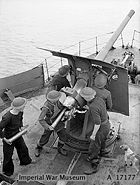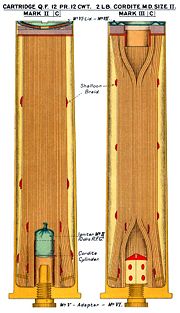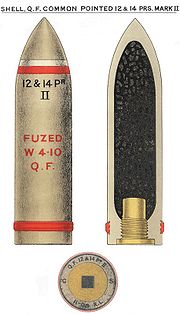
QF 12 pounder 12 cwt naval gun
Encyclopedia
The QF 12 pounder 12 cwt gun was a common 3 inches (76.2 mm) calibre naval gun introduced in 1894 and used until the middle of the 20th century. It was produced by Armstrong Whitworth
, Elswick
and used on Royal Navy
warships, and exported to allied countries. In British service, "12 pounder" was a rounded reference to the projectile weight and "12 cwt" referred to the weight of the barrel and breech : 12 hundredweight
= 12 x 112 pounds = 1344 pounds, to differentiate it from other "12 pounder" guns.
As the Type 41 3-inch (76.2 mm)/40 it was used on most early battleships and cruisers of the Imperial Japanese Navy
, though it was commonly referred to by its UK designation as a “12-pounder” gun.
 Mk I and II guns, of "built up" construction of multiple steel layers, served on many Royal Navy destroyer
Mk I and II guns, of "built up" construction of multiple steel layers, served on many Royal Navy destroyer
s up to and after World War I originally as primary and later as secondary armament against submarines and torpedo boat
s. They were also fitted as deck gun
s on D class
and E Class
submarines.
In World War II many Mk V guns, which had a "monobloc" barrel made of a single casting, served on smaller escort ships such as destroyers and on armed merchant ship
s, on dual-purpose high-low angle mountings which allowed it to be also used as an anti-aircraft gun.
RN, with solid wooden trails and utilizing small-diameter Cape wagon wheels. Their 10000 yards (9,144 m) range provided valuable long-range fire support for the army throughout the war. They were known as "long twelves" to distinguish them from the BL 12 pounder 6 cwt
and QF 12 pounder 8 cwt
which had much shorter barrels and ranges.
Lieutenant Burne reported that the original electric firing system, while working well under ideal conditions, required support of an armourer and the maintenance and transport of charged batteries in the field, which was generally not possible. He reports switching to percussion tubes for firing and recommends percussion for future field operations.
Another 6 guns were diverted from a Japanese battleship being built at Newcastle in January 1900, bought by Lady Meux and were equipped with proper field carriages by the Elswick Ordnance Company in Newcastle and sent to South Africa. Perhaps uniquely, the guns were donated directly to Lord Roberts
, the British commander in South Africa and became his personal property. They were known as the "Elswick Battery" and were manned by men from Elswick, recruited by 1st Northumberland Royal Garrison Artillery (Volunteers)
. The Elswick guns served throughout the war.
mounts.
Guns were traversed (moved from side to side) manually by the gunlayer as he stood on the left side with his arm hooked over a shoulder piece as he aimed, while he operated the elevating handwheel with his left hand and grasped the pistol grip with trigger in his right hand.
a number of coast defence guns were modified and mounted on special wheeled traveling carriages to create a marginally-effective mobile anti-aircraft gun.
The cordite propellant charge was normally ignited by an electrically-activated primer (in the base of the cartridge case), with power provided by a battery. The electric primer in the cartridge could be replaced by an adaptor which allowed the use of electric or percussion tube to be inserted to provide ignition.
Mark Z" guns. Thereafter production was in Japan under licence.
It was the standard secondary
or tertiary armament on most Japanese warships built between 1890 and 1920, and was still in service as late as the Pacific War
.
The gun was officially designated as “Type 41” from the 41st year of the reign of Emperor Meiji
on 25 December 1908. It was further re-designated in centimeters on 5 October 1917 as part of the standardization process for the Imperial Japanese Navy to the metric system
. Although finally classified as an "8cm" gun the bore was unchanged at 7.62 cm.
The Type 41 3-inch naval gun fired a 12.5 pounds (5.7 kg) high explosive shell.
Armstrong Whitworth
Sir W G Armstrong Whitworth & Co Ltd was a major British manufacturing company of the early years of the 20th century. Headquartered in Elswick, Newcastle upon Tyne, Armstrong Whitworth engaged in the construction of armaments, ships, locomotives, automobiles, and aircraft.-History:In 1847,...
, Elswick
Elswick, Tyne and Wear
Elswick is a ward of the city of Newcastle upon Tyne, England, in the western part of the city, bordering the river Tyne. One of the earliest references to the coal mining industry of the north east occurs in 1330, when it was recorded that the Prior of Tynemouth let a colliery, called Heygrove, at...
and used on Royal Navy
Royal Navy
The Royal Navy is the naval warfare service branch of the British Armed Forces. Founded in the 16th century, it is the oldest service branch and is known as the Senior Service...
warships, and exported to allied countries. In British service, "12 pounder" was a rounded reference to the projectile weight and "12 cwt" referred to the weight of the barrel and breech : 12 hundredweight
Hundredweight
The hundredweight or centum weight is a unit of mass defined in terms of the pound . The definition used in Britain differs from that used in North America. The two are distinguished by the terms long hundredweight and short hundredweight:* The long hundredweight is defined as 112 lb, which...
= 12 x 112 pounds = 1344 pounds, to differentiate it from other "12 pounder" guns.
As the Type 41 3-inch (76.2 mm)/40 it was used on most early battleships and cruisers of the Imperial Japanese Navy
Imperial Japanese Navy
The Imperial Japanese Navy was the navy of the Empire of Japan from 1869 until 1947, when it was dissolved following Japan's constitutional renunciation of the use of force as a means of settling international disputes...
, though it was commonly referred to by its UK designation as a “12-pounder” gun.
United Kingdom Naval service

Destroyer
In naval terminology, a destroyer is a fast and maneuverable yet long-endurance warship intended to escort larger vessels in a fleet, convoy or battle group and defend them against smaller, powerful, short-range attackers. Destroyers, originally called torpedo-boat destroyers in 1892, evolved from...
s up to and after World War I originally as primary and later as secondary armament against submarines and torpedo boat
Torpedo boat
A torpedo boat is a relatively small and fast naval vessel designed to carry torpedoes into battle. The first designs rammed enemy ships with explosive spar torpedoes, and later designs launched self-propelled Whitehead torpedoes. They were created to counter battleships and other large, slow and...
s. They were also fitted as deck gun
Deck gun
A deck gun is a type of artillery cannon mounted on the deck of a ship or submarine.The deck gun was used as a defensive weapon against smaller boats or ships and in certain cases where torpedo use was limited. Typically a crew of three; gunner, loader, and layer, operated the gun, while others...
s on D class
British D class submarine
There were plans for a further two, D9 and D10, but these were launched at Chatham Dockyard as HMS E1 and HMS E2.-See also:*Not to be confused with the United States D class submarine of 1909-1910.-Sources:...
and E Class
British E class submarine
The British E class submarines started out as improved versions of the British D class submarine. All of the first group and some of the second group were completed before the outbreak of World War I....
submarines.
In World War II many Mk V guns, which had a "monobloc" barrel made of a single casting, served on smaller escort ships such as destroyers and on armed merchant ship
Armed merchant ship
The term armed merchant ship may describe a number of similar ship modifications intended for significantly different missions. The term armed merchantman is generally used....
s, on dual-purpose high-low angle mountings which allowed it to be also used as an anti-aircraft gun.
Second Boer War (1899 - 1902) land service
The gun was primarily a high-velocity naval gun, with its heavy recoil suiting it to static mountings, hence it was generally considered unsuitable for use as a mobile field gun. An exception was made when the British Army were outgunned by the Boer artillery in South Africa and the Royal Navy was called on for help. Among other guns, 16 QF 12 pounder 12 cwt were landed from warships and were mounted on improvised field carriages designed by Captain Percy ScottPercy Scott
Admiral Sir Percy Moreton Scott, 1st Baronet GCB KCVO was a British Royal Navy officer and a pioneer in modern naval gunnery.-Early years:...
RN, with solid wooden trails and utilizing small-diameter Cape wagon wheels. Their 10000 yards (9,144 m) range provided valuable long-range fire support for the army throughout the war. They were known as "long twelves" to distinguish them from the BL 12 pounder 6 cwt
Ordnance BL 12 pounder 6 cwt
The Ordnance BL 12 pounder 6 cwt was a lighter version of the British 12 pounder 7 cwt gun, used by the Royal Horse Artillery. The "6 cwt" referred to the weight of the gun and barrel to differentiate it from other 12 pounders guns...
and QF 12 pounder 8 cwt
Ordnance QF 12 pounder 8 cwt
The Ordnance QF 12 pounder 8 cwt was a Royal Navy "landing gun" intended for navy use ashore. "8 cwt" refers to the weight of the gun and breech, approximately 8 cwt = 8 x = 896 lb. This was how the British often differentiated between guns of the same calibre or weight of shell...
which had much shorter barrels and ranges.
Lieutenant Burne reported that the original electric firing system, while working well under ideal conditions, required support of an armourer and the maintenance and transport of charged batteries in the field, which was generally not possible. He reports switching to percussion tubes for firing and recommends percussion for future field operations.
Another 6 guns were diverted from a Japanese battleship being built at Newcastle in January 1900, bought by Lady Meux and were equipped with proper field carriages by the Elswick Ordnance Company in Newcastle and sent to South Africa. Perhaps uniquely, the guns were donated directly to Lord Roberts
Frederick Roberts, 1st Earl Roberts
Field Marshal Frederick Sleigh Roberts, 1st Earl Roberts, Bt, VC, KG, KP, GCB, OM, GCSI, GCIE, KStJ, PC was a distinguished Indian born British soldier who regarded himself as Anglo-Irish and one of the most successful British commanders of the 19th century.-Early life:Born at Cawnpore, India, on...
, the British commander in South Africa and became his personal property. They were known as the "Elswick Battery" and were manned by men from Elswick, recruited by 1st Northumberland Royal Garrison Artillery (Volunteers)
101st (Northumbrian) Regiment Royal Artillery (Volunteers)
101st Regiment Royal Artillery are a M270 Multiple Launch Rocket System and Surveillance and Target Acquisition regiment of the Territorial Army with sub units throughout Northumbria. It is the only unit of the Territorial Army equipped with MLRS.The Regiment's role is to provide...
. The Elswick guns served throughout the war.
Coast Defence gun
Many guns were mounted on "pedestals" secured to the ground to defend harbours around the UK, and at many ports around the Empire, against possible attack by small fast vessels such as torpedo boats, until the 1950s. There were 103 of these guns (of a total 383 of all types) employed in coast defence around the UK as at April 1918. Many of these were still in service in World War II although they had by then been superseded by more modern types such as twin QF 6 pounder 10 cwtQF 6 pounder 10 cwt gun
The British QF 6 pounder 10 cwt gun"6 pounder" refers to approximate weight of projectiles, which was a traditional British way of denoting small guns. "10 cwt" referred to the approximate weight of the gun and breech in cwt rounded up : 10 cwt = 10 x 112 pounds = 1,120 pounds...
mounts.
Guns were traversed (moved from side to side) manually by the gunlayer as he stood on the left side with his arm hooked over a shoulder piece as he aimed, while he operated the elevating handwheel with his left hand and grasped the pistol grip with trigger in his right hand.
Army anti-aircraft gun
In World War IWorld War I
World War I , which was predominantly called the World War or the Great War from its occurrence until 1939, and the First World War or World War I thereafter, was a major war centred in Europe that began on 28 July 1914 and lasted until 11 November 1918...
a number of coast defence guns were modified and mounted on special wheeled traveling carriages to create a marginally-effective mobile anti-aircraft gun.
United Kingdom ammunition
UK shells weighed 12.5 lb (5.67 kg) filled and fuzed.The cordite propellant charge was normally ignited by an electrically-activated primer (in the base of the cartridge case), with power provided by a battery. The electric primer in the cartridge could be replaced by an adaptor which allowed the use of electric or percussion tube to be inserted to provide ignition.
 |
 |
 |
 |
 |
Cordite Cordite is a family of smokeless propellants developed and produced in the United Kingdom from 1889 to replace gunpowder as a military propellant. Like gunpowder, cordite is classified as a low explosive because of its slow burning rates and consequently low brisance... Cartridges Mk II & Mk III, 1914 |
Japanese service
The Japanese Type 41 3 inches (76.2 mm) naval gun was a direct copy of the QF 12 pounder. The first guns were bought from the UK firms as "Elswick Pattern N" and "VickersVickers
Vickers was a famous name in British engineering that existed through many companies from 1828 until 1999.-Early history:Vickers was formed in Sheffield as a steel foundry by the miller Edward Vickers and his father-in-law George Naylor in 1828. Naylor was a partner in the foundry Naylor &...
Mark Z" guns. Thereafter production was in Japan under licence.
It was the standard secondary
Battleship secondary armament
The secondary armament of a capital ship are smaller, faster-firing weapons that are typically effective at a shorter range than the main weapons...
or tertiary armament on most Japanese warships built between 1890 and 1920, and was still in service as late as the Pacific War
Pacific War
The Pacific War, also sometimes called the Asia-Pacific War refers broadly to the parts of World War II that took place in the Pacific Ocean, its islands, and in East Asia, then called the Far East...
.
The gun was officially designated as “Type 41” from the 41st year of the reign of Emperor Meiji
Emperor Meiji
The or was the 122nd emperor of Japan according to the traditional order of succession, reigning from 3 February 1867 until his death...
on 25 December 1908. It was further re-designated in centimeters on 5 October 1917 as part of the standardization process for the Imperial Japanese Navy to the metric system
Metric system
The metric system is an international decimalised system of measurement. France was first to adopt a metric system, in 1799, and a metric system is now the official system of measurement, used in almost every country in the world...
. Although finally classified as an "8cm" gun the bore was unchanged at 7.62 cm.
The Type 41 3-inch naval gun fired a 12.5 pounds (5.7 kg) high explosive shell.
Surviving guns
- A gun of the Elswick Battery that served in the Second Boer War is displayed in the Royal Artillery Museum, London
- Another Elswick gun is with 203 (Elswick) Battery RA (V)
- Mk V naval gun at Royal Artillery Museum, London
- Early coast defence gun at Newhaven FortNewhaven FortNewhaven Fort was built on the recommendation of the 1859 Royal Commission to defend the growing harbour at Newhaven, on the south coast of England...
, UK - Coast defence gun at Army Memorial Museum, Waiouru, New Zealand
- On Battleship Mikasa, Yokosuka, Japan
Books
- Text Book of Gunnery, 1902. LONDON : PRINTED FOR HIS MAJESTY'S STATIONERY OFFICE, BY HARRISON AND SONS, ST. MARTIN'S LANE
- Lieutenant C. R. N. Burne R.N., With the Naval Brigade in Natal (1899-1900). London: Edward Arnold, 1902
- Admiral Percy Scott, "Fifty Years in the Royal Navy" published 1919

